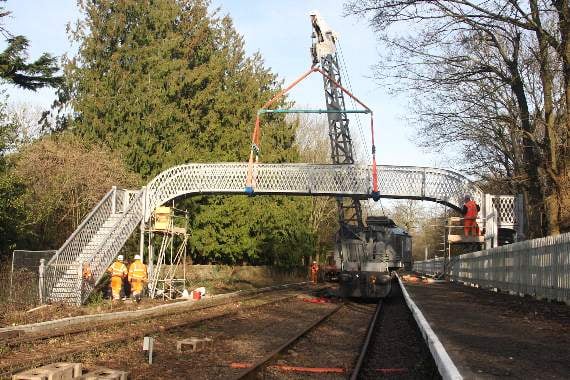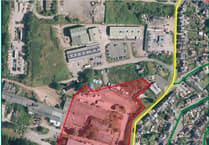A VICTORIAN rail footbridge which was taken away to be fully restored has been swung back into place ready to welcome pedestrians over the tracks again.
The Grade II-listed wrought and cast iron St Mary’s footbridge in Lydney was built 127 years ago and is the last existing piece of infrastructure of the old Severn and Wye Railway.
It was dismantled last June for resoration to take place at Lydney bridge builders Mabey, and was swung back into place by company staff and Dean Forest Railway volunteers on January 9, using the latter’s 61-year-old restored 15-ton diesel crane.
DFR spokesman Rob Harris said: “We are delighted that our beautiful Victorian original Severn and Wye Railway footbridge has been re-installed at its original site.
“Restoration included replacement of the deck section lower chords, 11 new cast iron stair risers, new deck plates, new finials on the lanterns and about 470 rivets.
“The listed building consent allowed the bridge, originally built as a massive kit of parts, to be dismantled and transported to a secure workshop for restoration, but even when dismantled the individual elements of the listed bridge remained listed.
“The DFR has renovated the footbridge for the benefit, appreciation and enjoyment of the local community, visitors and future generations.”
The restoration of the footbridge, which was orginally costed at around £150,000, will reconnect the historic footpath between the 12th century St Mary’s Church and Lydney Lake and offers a unique viewpoint of the DFR running below.
Having fallen into disrepair, it had been closed to the public since 2007 because of its unsafe condition, but will now reopen in time for the spring start of the DFR season.
The structure is a strong reminder of the town’s growth and
dependence on the railway and docks.
Rail historian Neil Parkhouse, who wrote Forest of Dean Lines and the Severn Bridge, said the railway was opened in 1868 on the route of the old Severn and Wye tramroad, and its heavy use ferrying coal to Lydney Docks saw the bridge constructed at St Mary’s Halt in 1892.
With workmen from Lydney Tinplate Works crossing the line near the engine shed and works sidings, plus people attending church services taking the shortest route, the Severn and Wye Railway (SWR) feared being liable for a major accident.
And although a long trade downturn meant severe financial difficulties for the firm, they funded the new bridge for the sum of £267, built by Glasgow company G Smith and Co and opened on September 26, 1892.
Children loved sliding down the bridge’s handrails, but their fun was ended in 1901 when iron nuts were fixed because of fears that they might fly onto the iron railings below.
The lifting work was done by the DFR’s eight-wheel heritage rail crane, restored over the last five years.
The well-supported restoration project was funded by the Rural Development Programme for England – Rural Tourism Infrastructure Growth Programme, part funded by the European Agricultural Fund for Rural Development.
DFR hopes to reopen the bridge for public use before the end of January, with a formal opening ceremony scheduled for Saturday, March 9.
St Mary’s Halt station, where a River Lyd culvert crosses beneath the track and bridge, was reopened in 1991, but also closed in 2014.
In its entry on the bridge, Historic England says: “This is a very complete survival, elegant and of great economy in engineering design.”
Michael Treacy, chief executive officer of Mabey, which manufactures and exports modular bridges around the world from its factory near Lydney Harbour, said: “We are very proud of the bridging products we manufacture here at Lydney, and our relationship with the local community is hugely important to us.
“We look forward to seeing the bridge open in March, so locals can appreciate and admire the Dean Forest Railway once again.”
The lifting work was done by the DFR’s eight-wheel heritage rail crane, built by Joseph Booth & Bros of Rodley, Leeds, and restored over the last five years.
The well-supported restoration project was funded thanks to donations and funding from the Rural Development Programme for England – Rural Tourism Infrastructure Growth Programme, part funded by the European Agricultural Fund for Rural Development.
DFR hopes to reopen the bridge for public use before the end of January, ahead of the formal opening ceremony on March 9.





Comments
This article has no comments yet. Be the first to leave a comment.